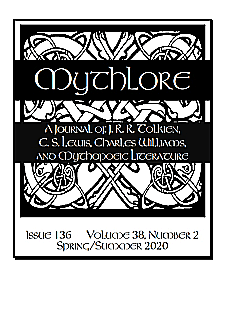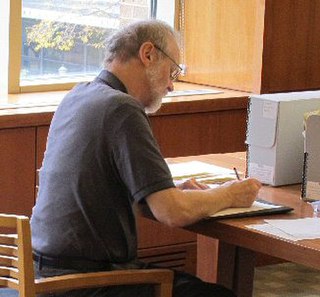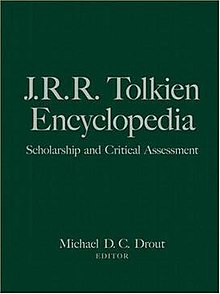Denethor II, son of Ecthelion II, is a fictional character in J. R. R. Tolkien's novel The Lord of the Rings. He was the 26th ruling Steward of Gondor, committing suicide in the besieged city of Minas Tirith during the Battle of the Pelennor Fields.

The Adventures of Tom Bombadil is a 1962 collection of poetry by J. R. R. Tolkien. The book contains 16 poems, two of which feature Tom Bombadil, a character encountered by Frodo Baggins in The Lord of the Rings. The rest of the poems are an assortment of bestiary verse and fairy tale rhyme. Three of the poems appear in The Lord of the Rings as well. The book is part of Tolkien's Middle-earth legendarium.

The Atlas of Middle-earth by Karen Wynn Fonstad is an atlas of J. R. R. Tolkien's fictional realm of Middle-earth. It was published in 1981, following Tolkien's major works The Hobbit, The Lord of the Rings, and The Silmarillion.
The works of J. R. R. Tolkien have generated a body of research covering many aspects of his fantasy writings, principally The Lord of the Rings and The Silmarillion, along with the large legendarium that remained unpublished on his death in 1973, and the constructed languages that he invented in connection with these, especially the Elvish languages that gave rise to many of the names he used, Quenya and Sindarin. Scholars from different disciplines have examined the linguistic and literary origins of Middle-earth, and have explored many aspects of his writings from Christianity to feminism and race.

Mythlore is a biannual peer-reviewed academic journal founded by Glen GoodKnight and published by the Mythopoeic Society. Although it publishes articles that explore the genres of myth and fantasy in general, special attention is given to the three most prominent members of the Inklings: J. R. R. Tolkien, C. S. Lewis, and Charles Williams. The current editor-in-chief is the Tolkien scholar Janet Brennan Croft. The Tolkien Society describes Mythlore as a "refereed scholarly journal".
Michael D. C. Drout is an American Professor of English and Director of the Center for the Study of the Medieval at Wheaton College. He is an author and editor specializing in Anglo-Saxon and medieval literature, science fiction and fantasy, especially the works of J. R. R. Tolkien and Ursula K. Le Guin.

Tolkien Studies: An Annual Scholarly Review is an academic journal publishing papers on the works of J. R. R. Tolkien. The journal's founding editors are Douglas A. Anderson, Michael D. C. Drout, and Verlyn Flieger, and the current editors are Michael D. C. Drout, Verlyn Flieger, and David Bratman. It states that it is the first scholarly journal published by an academic press in the area of Tolkien research.
J. R. R. Tolkien's bestselling fantasy novel The Lord of the Rings had an initial mixed literary reception. Despite some enthusiastic early reviews from supporters such as W. H. Auden, Iris Murdoch, and C. S. Lewis, literary hostility to Tolkien quickly became acute and continued until the start of the 21st century.
The Ainur (singular: Ainu) are the immortal spirits existing before the Creation in J. R. R. Tolkien's fictional universe. These were the first beings made of the thought of Eru Ilúvatar. They were able to sing such beautiful music that the world was created from it.
The Maiar are a fictional class of beings from J. R. R. Tolkien's high fantasy legendarium. Supernatural and angelic, they are "lesser Ainur" who entered the cosmos of Eä in the beginning of time. The name Maiar is in the Quenya tongue from the Elvish root maya- "excellent, admirable".
Arden Ray Smith is a member of the Elvish Linguistic Fellowship and holds a Ph.D. in Germanic Linguistics from the University of California, Berkeley. He has published numerous articles relating to the languages constructed by J. R. R. Tolkien. He was a columnist and editor of Vinyar Tengwar, for which he wrote the popular column "Transitions in Translations", in which odd elements in translations of Tolkien's work were described and commented upon.
The geography of Middle-earth encompasses the physical, political, and moral geography of J. R. R. Tolkien's fictional world of Middle-earth, strictly a continent on the planet of Arda but widely taken to mean the physical world, and Eä, all of creation, as well as all of his writings about it. Arda was created as a flat world, incorporating a Western continent, Aman, which became the home of the godlike Valar, as well as Middle-earth. At the end of the First Age, the Western part of Middle-earth, Beleriand, was drowned in the War of Wrath. In the Second Age, a large island, Númenor, was created in the Great Sea, Belegaer, between Aman and Middle-earth; it was destroyed in a cataclysm near the end of the Second Age, in which Arda was remade as a spherical world, and Aman was removed so that Men could not reach it.

Tolkien: A Cultural Phenomenon is a 2003 book of literary criticism by Brian Rosebury about the English author and philologist J. R. R. Tolkien and his writings on his fictional world of Middle-earth, especially The Lord of the Rings. A shorter version of the book, Tolkien: A Critical Assessment, appeared in 1992. Rosebury examines how Tolkien imagined Middle-earth, how he achieved the aesthetic effect he was seeking, his place among twentieth century writers, and how his work has been retold and imitated by other authors and in other media, most notably for film by Peter Jackson.
John Garth is a British journalist and author, known especially for writings about J. R. R. Tolkien including his biography Tolkien and the Great War and a book on the places that inspired Middle-earth, The Worlds of J. R. R. Tolkien.

Richard Carroll West was an American librarian and one of the first Tolkien scholars. He is best known for his 1975 essay on the interlace structure of The Lord of the Rings, for which he won the 1976 Mythopoeic Scholarship Award for Inkling Studies.
David Bratman is a librarian and Tolkien scholar.
Jason Fisher is a Tolkien scholar and winner of a Mythopoeic Scholarship Award in 2014 for his book Tolkien and the Study of His Sources: Critical Essays. He served as the editor of the Mythopoeic Society's monthly Mythprint from 2010 to 2013. He is the author of many book chapters, academic articles, and encyclopedia entries on J. R. R. Tolkien.
Marjorie Burns is a scholar of English literature, best known for her studies of J. R. R. Tolkien.
Between 1954 and the start of the 21st century, there was intense literary hostility to J. R. R. Tolkien, directed especially to his bestselling work The Lord of the Rings.

Tolkien's Art: 'A Mythology for England' is a 1979 book of Tolkien scholarship by Jane Chance, writing then as Jane Chance Nitzsche. The book looks in turn at Tolkien's essays "On Fairy-Stories" and "Beowulf: The Monsters and the Critics"; The Hobbit; the fairy-stories "Leaf by Niggle" and "Smith of Wootton Major"; the minor works "Lay of Autrou and Itroun", "The Homecoming of Beorhtnoth", "Imram", and Farmer Giles of Ham; The Lord of the Rings; and very briefly in the concluding section, The Silmarillion. In 2001, a second edition extended all the chapters but still treated The Silmarillion, that Tolkien worked on throughout his life, as a sort of coda.







